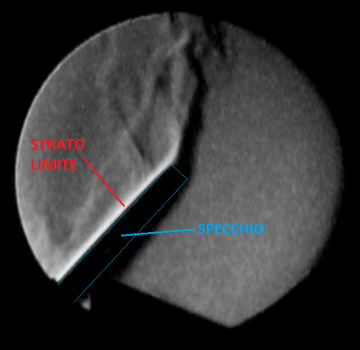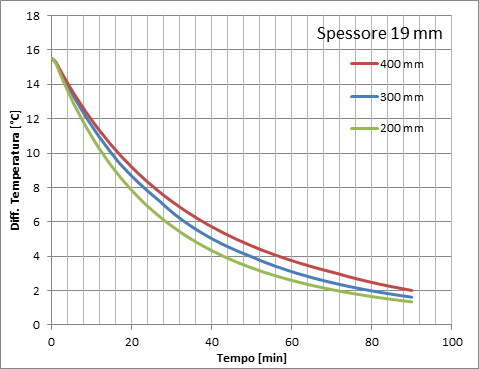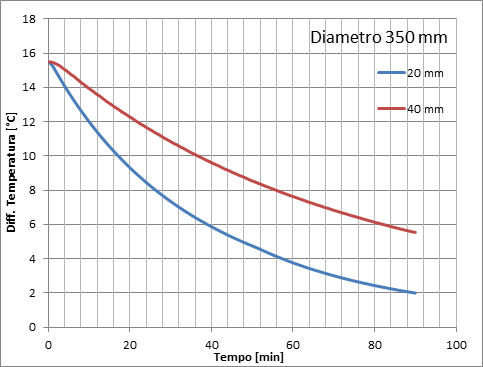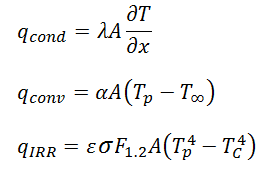In order to facilitate an excellent evening observing through a telescope, We know that this must be in perfect conditions of stability, and collimation and thermal equilibrium. This last issue will be analyzed in this post, to highlight what are the main parameters affecting the optics acclimatization time, The possible measures to improve the problem and the advantages-disadvantages of these measures.
Generally the telescope is stored in a ’ 'environment which in most cases is located at a different temperature than the external environment to which then will find the same during the observation. . This means that you will have to wait some time to enable the ’ 'optics to bring in temperature with the air, , otherwise the non-perfect view of the eyepiece, , due to the air convection currents that are established above the mirror and that induce distortions in the optical beam (this is because the refractive index of the air varies with the temperature of the same).
The time required for the optics in thermal equilibrium arrivals is not easy to estimate, because it depends on many factors such as: glass thickness, jump of temperature, presence of fans or not, environmental conditions, presence of wind, etc…To try to determine the approximate time that, I developed a small computer in an excel sheet that tries to simulate probably the cooling process. This was possible, calibrating some parameters of the software using experimental data acquired from different real tests made specially.
The simulator can be downloaded from the links below, in .xls or .xlsx format:
Download file: mirror cooling simulator (Excel 2011 .xlsx)
Download file: mirror cooling simulator (Excel 97-2003 ,xls)
To address this problem we must first introduce some basic concepts on the methods by which heat can spread.
the heat exchange between the bodies can be carried out essentially in three different ways, by conduction, by convection or radiation.
The conduction occurs at the microscopic level in the form of oscillation of the molecules of the material, which by interacting with each other to ensure the heat transport. This oscillation increases with the thermal energy accumulated in the body ie increasing temperature.
Convection is the process by which the heat is propagated within the liquids and gases, due to density gradients that induce convective movements in the fluid.
The’ instead irradiation is the process by which the heat (in the form of electromagnetic energy), It is exchanged by two surfaces having different temperatures.
And these are the formulas that define these models:
Where:
q: heat exchanged
l: Thermal conductivity of the material (conductive coefficient)
A: area of the heat exchange surface
T: temperature
a: convection coefficient (convective coefficient)
Tp: Wall Temperature (or of the mirror surface)
T∞: Temperature of the air or the fluid away from the surface
e: emissivity material (coefficient of irradiation)
p: Stefan-Boltzmann constant
F1.2= Factor of view
Tc= Temperature of the upper atmosphere with which the mirror exchanges heat (approximately equal to -80 °C)
As you can see by all three methods, the heat exchanged depends essentially over from exchange (What fixed by the mirror size) from the temperature difference and by a coefficient that take the name of conductive coefficient, convective or radiation depending on which process we are talking.
The conduction in the state of a mirror cooling study interesting to understand the speed with which the glass is able to transport the heat from its center toward the outer surfaces where effectively the heat of the mirror is transferred to air.
We can not intervene in this matter to improve it, since the conductive coefficient depends only on the characteristics of the material and unless it is decided to fabricate the mirror with material other than glass, the situation can not be improved. Is’ also true that different types of glass may have different conduction coefficients, but generally the types for optical use have comparable values. A different material, however, may have a different specific heat and this coefficient indicates the amount of heat that a body is able to store for each kilogram of mass before raise its temperature 1 °C. A material with high specific heat takes much more time to be cooled compared to one with a lower specific heat, being greater than the amount of heat by having to dispose of an equal temperature jump. Once decided the material and manufactured the mirror these values remain fixed and we will have to intervene on other aspects to decrease the time required to reach thermal equilibrium.
The fact that there is the conductive coefficient (Thermal conductivity of the material) It indicates the presence of a thermal resistance which tends to slow down the propagation of heat and this is responsible for the temperature difference during the cooling that is established between the outer surface and the mirror heart.
The convection instead affects the outer surfaces and it is precisely by convection that the heat is transferred from the mirror to air. In this case, however, the convective coefficient also depends (not only) by the speed with which it moves the air close to the surface and this action can be taken, for example by applying the fans.
Often radiation is neglected, but this process causes the mirror disposes of heat in the form of electromagnetic waves at high atmosphere which is located approximately in -80 °C. The consequence of this is that the final temperature of the mirror may fall below the ambient temperature favoring the formation of condensation on the surface. Even the radiation depends on only parameters that we are not allowed to change with external devices, because it depends only on the material properties (in this case the deposited aluminum layer on the upper surface to make the reflective mirror).
WAYS TO COOL
For natural convection:
The simplest method, but also the longest to get acclimatization, It is simply to leave the stationary mirror on his cell. A heat exchanger of this type is said to natural convection, in which the currents of air moving above the mirror only for temperature difference and therefore density, creating recirculation due to the rise of’ hot air and the consequent descent of colder air. Since the air moves only by density gradients in the game speed they are modest and the convective coefficient accordingly is modest, the order of 5-20 W/m²K.
This explains the extra time required when using this technique.
Shown below is a video in which you can see very well how the air to move above and below the mirror in this type of process and how it forms a stationary area of modest dimensions of hot air that surrounds the entire mirror. This area is called the boundary layer or boundary layer and is the main culprit that prevents a good heat exchange between the mirror and air (image below this layer looks very good).

Also note how the decrease of the temperature difference between the mirror and the environment, also the speed and air turbulence are reduced.
For forced convection:
As I mentioned before in order to reduce the time required to reach thermal equilibrium, you can add fans that blow air against the surface of the mirror, thus increasing the velocity of the fluid and being able to break of all or part of the boundary layer and bringing the convective coefficient to values of 100-500 w/m²K.
The fans can be positioned both below and above the mirror. For thicknesses less than 30 mm one can adopt the solution with a single fan positioned in the lower part of the mirror, while for greater thicknesses would be appropriate to equip the even of a telescope that puffs on the upper surface.
As you will note later increase more and more the size of the fan is not convenient because the heat exchange has a limitation due to the thermal resistance of the glass which tends to slow down the transport of heat from its center towards the outer surface.
In addition it would not make sense too increase the size of the fan to improve the time of acclimatization, because of against the larger size tend to cause greater vibrations negating the improvements obtained on the thermal side.
Here are the effects that a lower and an upper fan create on the air on the mirror current.
Fan below:
Fan above:
Note how the action of the fan below is not only confined to the lower zone of the mirror, but also go to modify significantly the air flow field on the upper face optics increasing the heat exchange. In the second part of the video “fan sotta” one sees how the air exiting radially from the lower face optics drag away even the air from the upper surface. the same also happens with the fan positioned above.
OTHER METHODS
more exotic alternative methods can be employed, as one in which a grid is positioned above the mirror on which rest the tile from freezer (for thermal ice bags) to decrease the temperature of the air that comes into contact with the mirror thereby increasing the thermal gradient and consequently the efficiency of the cooling process.
In this regard one can see from the video as a freezer mail tile above the mirror induces of descending currents of cold air that go to interact with the surface of the mirror.
This type of solution has never been tested by the writer as I consider the most viable solutions with fans, but if anyone has ever tried his hand in this technique, and tested the benefits-disadvantages can communicate even in the comments below so as to make interactive communication.
Alternatively, a method that looks promising is the one that tries to suck in the boundary layer present on the upper face of the mirror, surrounding the stretched with a particular structure connected to a suction fan that once lit creates a depression along the circumference of the mirror causing the air above it to evacuate radially.
This method aims to be able to cool the mirror with the benefits in terms of speed permitted by the fans, succeeding simultaneously to create a motion of laminar air evacuates type while the upper surface of the mirror so as to be able to use from the outset of a good vision eyepiece.
I ran a test of this method, although I have not had great experience of the cash invoice that surrounds the mirror to get sucked so, if you studied better, you might get better results. Precisely because of the presence of the body around the mirror, however, it may not be able to see how it behaves the air just above the surface, but a couple of centimeters onwards.
Although you can not see the layer of air in contact with the mirror (boundary layer) I have reason to believe that this method is not able to break the entire layer, because in spite of this be sucked , heat mirror the constantly renewed. E ', however, very clear that the whole air column above the mirror proves much better than seen in other videos. I believe this is the reason why many argue that this the best solution immediately viewing eyepiece, not so much for the real break the boundary layer, but for the improvement of the whole column of air above it(It is evident in the video the difference between natural convection before energizing the fan and sucked after the ignition). The solutions with fan instead could break the boundary layer but created a great deal of turbulence in the air.
SUMMARY:
Every one of these methods seeks to increase the speed with which the optical bring to ambient temperature going to act on one of the three parameters of which reference was made before and which determine the amount of heat that can be removed:
Increase the convective coefficient: By leveraging the use of fans.
Increasing the temperature difference between the mirror and air incident on the surface: Using the freezer from tile.
By increasing the exchange area: This can only be done a priori, when one realizes the glass blank and is one of the advantages that prefissano to reach the alveolar mirrors, which have a surface-to-volume ratio far greater than one classic mirror.
EVALUATION OF EFFECT OF VARIOUS PARAMETERS ON TIME ACCLIMATIZATION
After analyzing the experimental data and those made by the simulations you can observe how the various parameters affecting the cooling time:
(all cases refers to a natural convection cooling in, except in cases where it is otherwise indicated)
Mirror diameter with the same thickness:

As can be seen the diameter of the mirror does not significantly influence the time of acclimatization. So mirrors of greatly different dimensions, but having the same thickness will cool with similar timing.
Thickness of the mirror with the same diameter:

The thickness will greatly affect the cooling time and to a doubling of the thickness can be expected to’ about a doubling of the time required to reach thermal equilibrium, at least with regard to the natural convection.
Use of fans or not:

Is’ evident that the improvement is achieved with the addition of fans that increase the convective heat transfer and it is for this reason that it is useful to provide for the installation from the outset of this device on its own telescope. still increasing the size of the fan you will be seen that the curves begin to become compacted towards a limit curve due to the heat transport limitations inside the mirror, negating the slight improvements can be obtained at the expense of greater vibrations.
